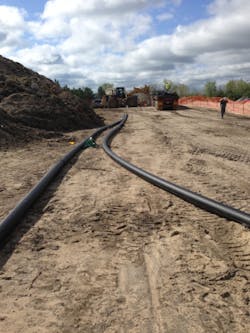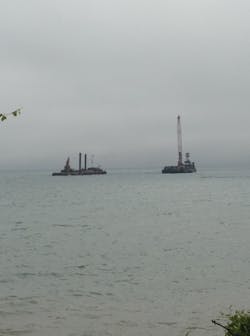Case Study: Advanced polyethylene pipe protects new Lake Huron water supply line
FLINT, Mich. - Feb. 9, 2016 -- Due to expected water rate increases of up to 15 percent a year, the Karegnondi Water Authority (KWA) is building a new water supply pipeline from Lake Huron. It is estimated that when completed in 2016, the 74-mile long new water line will save Flint and surrounding communities millions of dollars in increased water rates each year. The first segment of the project, a mile-long, 78-inch diameter intake pipeline from the lake to onshore pump stations, was completed in September. KWA, however, had to find a way to deal with zebra mussels in the lake which adhere themselves to water intake lines, restricting flow and clogging the pipe.
In 1989, Monroe, Michigan lost its water supply for three days due to massive numbers of zebra mussels clogging the city’s water-intake pipeline. Since then, city water suppliers have had to retool their water-intake systems or apply chemical treatment. The U. S. Fish and Wildlife Service estimates the potential economic impact from zebra mussel infestation for U. S. and Canadian water users within the Great Lakes region to be $3 to $5 billion during the next 10 years.
While oxygen deprivation, temperature treatments, exposure and dry-up, passive and barrier filtration, removable substrates, electric currents and sonic vibration have had limited success in fighting the zebra mussel problem, a regular dosing of sodium hypochlorite into the water intake structure has proven to be the most effective way to control zebra mussels and prevent the mussels from clogging up the intake pipe. KWA specified an innovative pipe system that is designed to deliver the sodium hypochlorite solution to protect the water intake line.
Traditional pipe cannot effectively deal with the oxidizing and caustic nature of sodium hypochlorite. Also, the plan was to horizontally directionally drill (HDD) the last 300 feet of pipe 40 feet under the lake bed and shore to the water lift station. These needs would require a pipe with a high degree of structural strength, flexibility and advanced resin characteristics. The Poly-Flo® Advanced Polyethylene (PE) (PE100RC) piping system with four-inch diameter (DR11) carrier pipe surrounded by a six-inch (DR17) containment pipe from Asahi/America was chosen. The pipe's physical properties will allow the plant to treat the water supply line with sodium hypochlorite to prevent mussel infestation and build-up without damaging the pipe, fittings or welds. The double wall pipe design also protects against leaking of sodium hypochlorite into the surrounding waters.
Because of its unitary construction, the Poly-Flo double wall PE pipe system can be installed like a single wall system. This is especially important in installations with fluctuating temperatures, chemical use and applications like this that require directional drilling. According to the company, the Poly-Flo system is not a disk-centric system like traditional double containment systems.
To install the system, sections of the double wall PE pipe were welded onshore into lengths of 200 to 300 feet, floated on the lake surface, then submerged to the lake floor and attached to the top of the 78-inch concrete intake pipe that is buried 44 feet under the lakebed.
Asahi/America, along with its distributor, Harrington Industrial Plastics (Livonia, MI) provided 11,000 feet of 4x6 Poly-Flo Advanced PE double containment pipe and fittings.
"This installation was ideally suited for Advanced Polyethylene pipe," stated Tony Radoszewski, president of the Plastics Pipe Institute, Inc. (PPI). "The contractor and the water authority were able to maximize the benefits only this plastic piping provides: chemical resistance, corrosion resistance, impact resistance, ductility, creep rupture strength, pressure load resistance and exceptional weldability.
"The double-wall pipe was a true problem solver in this instance. It was the solution best able to handle the sodium hypochlorite required to prevent zebra mussel infestation. Plus PE100RC resin is resistant to both environmental stress (point loads) and chemical stress, and was rugged and durable enough to not require special protection during installation and after it was in the ground. It was also flexible enough to be installed by trenching and horizontal directional drilling far into the lakebed." PPI is the major trade association representing all segments of the plastic pipe industry and is dedicated to promoting plastics as the material of choice for pipe applications. Asahi/America is a member company of PPI.
Fusing Confidence
"Heat fusing sections of polyethylene pipe provides systems with an excellent advantage - no leaks," stated Camille George Rubeiz, P. E., director of engineering for PPI’s Municipal Division. "And in this case it was a critical requirement. For more than 50 years PE pipe has been used in gas and water applications because of zero leakage allowance plus the inherent characteristics of durability, flexibility, chemical and stress crack resistance. This double-walled Asahi/America product is actually coextruded, meaning that the outside and inside pipes plus the reinforcing ribs are all molded at the same time. This adds to the integrity and strength of the pipe. Today, the industry continues to improve the properties of the polyethylene resin and we are seeing numerous new applications across many different and diverse industries. This Lake Huron project is just one of those recent advanced projects."
For additional information, go to the Plastics Pipe Institute's website at: www.plasticpipe.org.
About PPI:
The Plastics Pipe Institute Inc. (PPI) is the major trade association representing all segments of the plastic pipe industry and is dedicated to promoting plastics as the material of choice for pipe applications. PPI is the premier technical, engineering and industry knowledge resource publishing data for use in development and design of plastic pipe systems. Additionally, PPI collaborates with industry organizations that set standards for manufacturing practices and installation methods.

